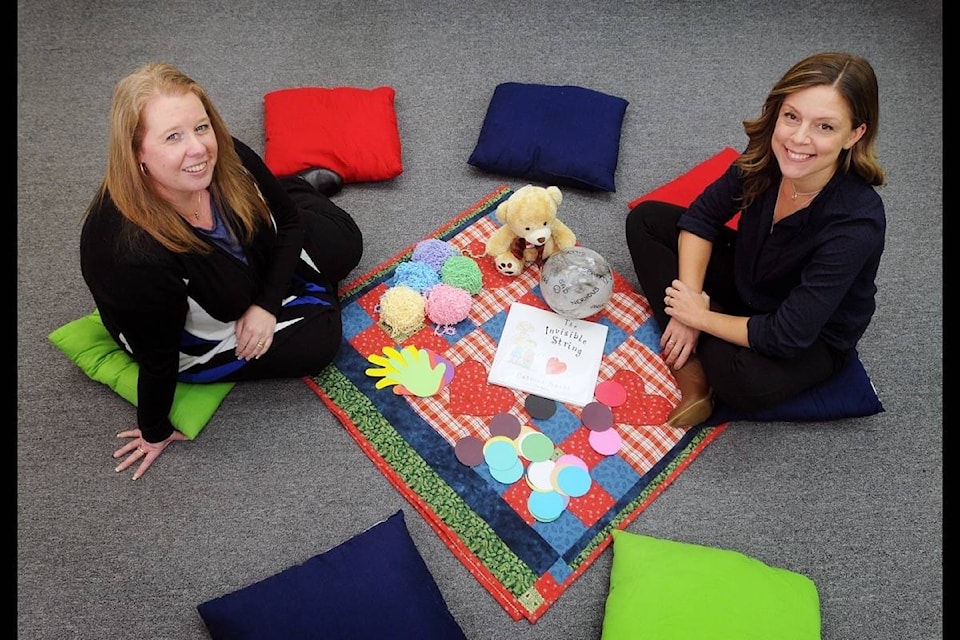Children are often the forgotten mourners when it comes to grieving over the death of a loved one.
One minute they can be screaming and having a breakdown, kicking and crying, but smiling the next.
They can appear to be coping well with a death when really they are not.
“What I hear a lot from parents and grandparents is behaviour changed or they are not sleeping or they are being more angry, being naughty more,” said Susanne Lamb, bereavement coordinator with the Ridge Meadows Hospice Society.
“It’s not always recognized that it is coming from the grief.”
A free six-week program through the Ridge Meadows Hospice Society puts grieving children first.
Circle of Hearts is geared towards children six to 12 years old and is an hour and a half to two hours each week, after school.
“As long as the hospice society has been around, we’ve supported children in the community,” said Lindsey Willis, coordinator of palliative support services with the society.
Children’s grief support groups started at the society in 2006. Initially, the society brought in an expert in education to help with the curriculum, shape what the program would look like and train staff and volunteers so they could offer it to children in the community.
Currently it is run on an as-needed basis. But the group will be offered with as little as four to six registered children.
Typically how the program works is that there is an initial meeting with the children and their caregivers to determine if they are interested in doing it.
The six weeks involves a lot of crafts, play, and story reading. And it is a space for the children only.
“It gives the children more of a safe space without their parents being there. I think what we find is when the parents aren’t in the room, the kids interact with each other more,” Lamb said.
Sessions start with children taking a seat on cushions arranged in a circle on the floor. In the middle is a quilt.
“We initially start off by just saying each others names. We try to make it as much fun as possible,” said Lamb.
“Just to break the ice a little bit, you have to throw the ball to someone and you have to say that person’s name.”
Pieces of string are also tied around the children in a circle.
“That is a visual symbol of confidentiality, that whatever happens in this circle stays in this circle. They listen to that. They really listen to that,” said Willis.
Games are used to spur conversation in the class.
On a grey and white ball in black marker are the words of many common emotions people can feel in their lives, including silly, great, scared, hopeless, nervous, lost, loved, angry and sad. The children throw the ball to each other and whatever emotion is the closest word to their right thumb, they will talk about.
“Just to get them started talking about what that feeling felt like at the time,” explained Lamb.
Each week the group will do different activities. Sometimes the group will make memory boxes for their loved ones or decorate picture frames or potted plants. With the picture frames, the children are asked to bring a picture of their loved one, then they paint and decorate the frame.
“What we’ve found is that they paint them with either their favourite colours or the person that they’ve lost, their favourite colours, and it is just like a memory for them,” said Lamb.
But what is more interesting to Lamb and Willis is what the children talk about during the craft times.
“There was one group I think they talked about nothing but a video game at one point,” said Lamb.
But there is interaction.
And every now and then they can be heard talking about a loved one.
Once they connect with one another, the children tend to open up.
Willis is seeing an increased number of children coming to the program because there has been a sudden, tragic loss in their family.
“That’s newer to the hospice society,” she said.
One eight-year-old girl had an older brother who died of a drug overdose.
“I think there is the assumption that kids are coming because grandparents are dying,” but that is not necessarily the case, said Willis.
More children are attending the group because family members have overdosed or been involved in fatal car crashes and they don’t know how to grieve, who to turn to, or how to safely channel their emotions.
“Kids don’t really know how to say to an adult, ‘This is how I feel and this is why I am upset,’ so they act it out instead,” said Lamb.
“When they come in here and there is no adult, no parents, it gives them that safe space, that freedom if you like, ‘It’s OK that I can feel that,’” she said.
Willis said one of the key pieces children gain from attending the grief group is the connections they make with other children.
“One of the biggest things with kids or anybody is feeling that you are the only one and that you are alone, especially when you are a child who has had a loved one die in a tragic situation or even die of cancer,” said Willis.
“For them, that’s their world. They are the only one who this has happened to. To be with another kid and you are not alone, that is really healing in itself,” she added.
At the end of the course, participants are asked if they want to present memory boxes filled with objects to help them remember their loved one in a final ceremony with their parents or caregivers.
“It’s incredible how confident some of them are. It’s incredible in that some of them just do it. Some of them also feel safe enough to start crying,” said Willis.
“We never stop healing no matter what age we are.”
